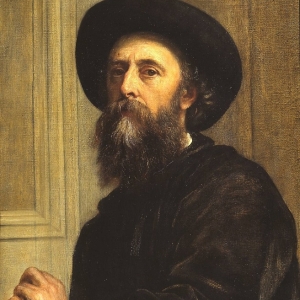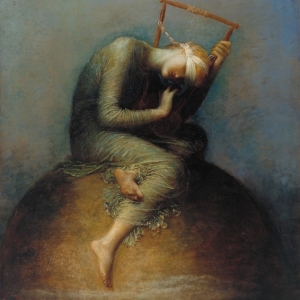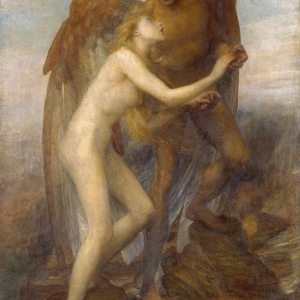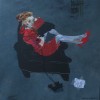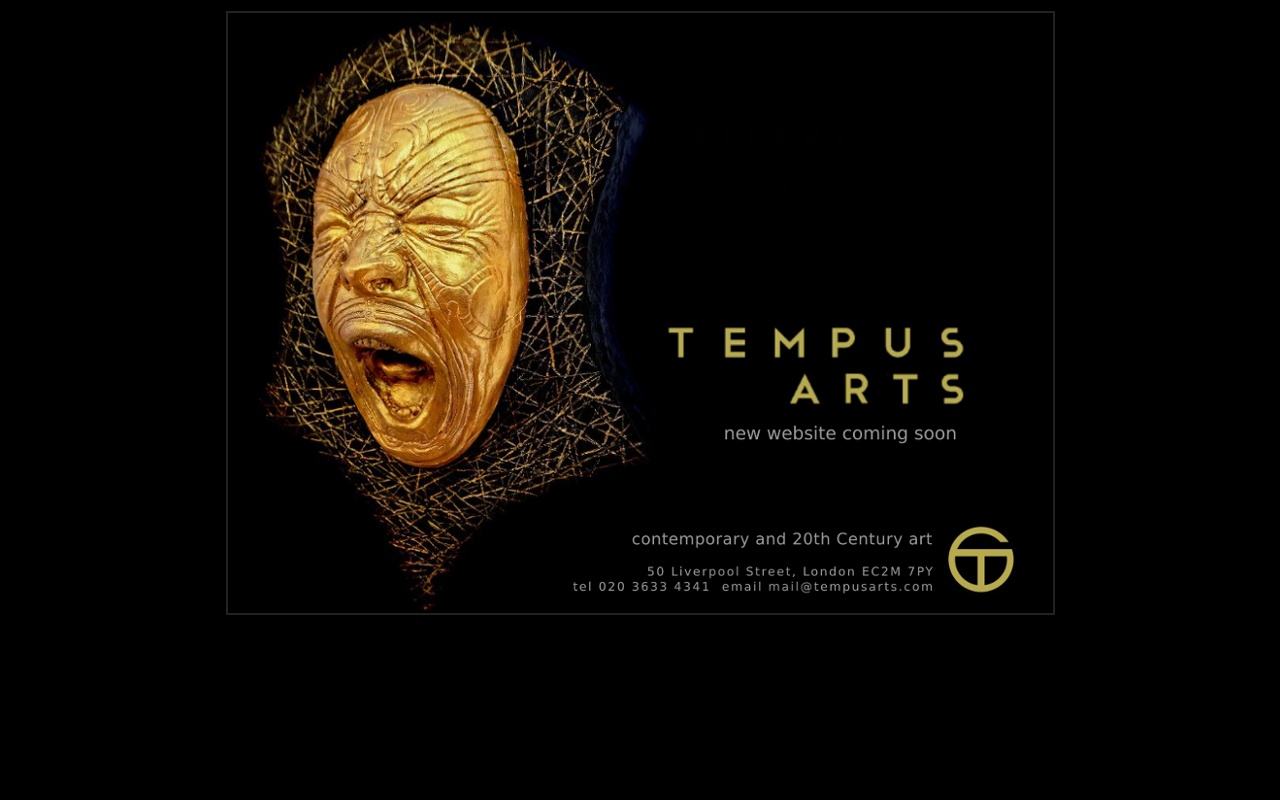It is difficult to categorize George Frederic Watts (1817-1904), a British painter and sculptor whose career spanned more than seventy years. He celebrated the statuary and stonework of the Classical world, particularly the Parthenon Marbles. Aspiring to the greatness he saw in the works of the Old Masters, he painted large, complex histories; inspired by Pre-Raphaelite friends, creating scenes steeped in colour and sentimentality. His works captured subjects as diverse as the Minotaur, Little Red Riding Hood, Genghis Khan, contemporary authors and life itself. Despite the incredible volume of his output and the diversity of its subjects, one element that runs throughout his works is a simultaneous interest in humanity at both an individual and universal level.
Born and raised in London, Watts experienced his first professional success in 1837 when three of his works were accepted to the Royal Academy Summer Exhibition. Two of these were portraits, and one a painting of a wounded heron. The third picture shows a large white bird on its back, head toward with the viewer, beak open and wings outspread. “It is, as I have said, a thing painted clearly with a humanitarian object,” G. K. Chesterton wrote, observing The Wounded Heron in 1904:
It depicts the suffering of a stricken creature…it depicts the pathos of a dying and the greater pathos of living. Since then…the wings of the heron have widened till the embrace the world with the terrible wings of Time or Death…He has changed the plan of operations until it includes Heaven and Tartarus. He has never changed the theme.
Here Chesterton, looking back on the painting in the year of Watts’ death, captures the essence of his friend’s art. He refers to the interplay of commonplace and the grandiose, as well as a powerful sentimentality, and it is these elements that reoccurred throughout the artist’s work.
As a young man, Watts travelled in Italy developing a wide social circle that included patrons as well as other artists. Upon returning to England in the mid 1840’s, however, he found that history painting had gone out of critical favor. During the period that followed, he developed his social circle in London forming relationships with other artists and thinkers including the poet Alfred Tennyson, the photographer Julia Margaret Cameron and the painter Dante Gabriel Rossetti.
Watts continued painting murals and portraits, but also explored more explicitly his interest with human suffering. Found Drowned, an oil painting from c. 1850, was one of a short series of social realist paintings. In it, the background is a murky grey-blue London skyline above the oily-looking Thames. Highlighted in the foreground is the figure of a pale woman lying on her back in the sand, her arms thrown out behind her — not unlike the figure of the earlier Heron. As the name of the image suggests, she is drowned, and her legs remain half-submerged. Using a theme from various popular tragic, moralizing poems of the day, Found Drowned tells the end story of a woman who has fallen into social and moral shame, and committed suicide. Set beneath a bridge, the viewer witnesses the scene framed through two stone supports, as though it is the observer who has happened upon the woman. Though Watts produced few such paintings, in Found Drowned his interest with the social condition, individual morality and imminent mortality are evident.
As Watts’ fame grew, he became steadily more interested in working on his “symbolism”. His development of universal allegorical language often informed these images. During the 1860’s and 1870’s, he spent an increasing amount of time creating “painted poems” that he saw as didactic moral tools for his public and the world.
Many of his works pay homage to the intellectual and emotional importance of philosophy, religion and morality, and the grand sweep of human history For example, Life and Love (c. 1884-5), shows his interest in the allegorical and pseudo-mythological. In the vertical composition, Love, a young man with large, powerful wings, takes the hands of Life, a young, vulnerable and pale woman. Both nude, the figures ascend a rocky slope, with flowers springing up behind them where they’ve walked. Watts once said it was his most important message for the age, representing the need for Love to guide, protect and elevate human Life.
Both Life and Love and Found Drowned demonstrate Watt’s concern with the universal and personal. While a particular woman is portrayed in Found Drowned, she serves as a larger symbol for lost virtue. Life and Love however, is a scene told through a ‘universal allegorical language,’ but one that was personal to Watts to be observed and understood by each viewer individually and through his or her own life.
In the last years of the 1880’s, two of Watts’ most lasting works demonstrated his interest in morality and mortality, humanity and man. Watts’ painting Hope (1886), perhaps his most recognizable Symbolist painting, was received with mass approval. It was so popular that he created another to donate to the National Collection. The otherworldly image shows a blindfolded woman sitting on a globe and plucking at the last remaining string on a harp. Originally it was intended for a larger cycle, Watts’ House of Life project. Though the cycle was never fully realized, it was initially planned to be a programme of all of human history. Less than a year later, in contrast to the otherworldly Hope, Watts created the Memorial to Heroic Self Sacrifice, a public monument in London. The Memorial consists of rows of plaques, each dedicated to a man or women who died while rescuing another. Rather than celebrating the human soul on a grand scale, this looks like individual cases for acts of heroic goodness.
However, one of the clearest ways Watts exhibited his dual interest both in the man and humanity was through attitude towards himself. As he grew older he pursued a number of means to preserve his art and his identity beyond the grave. For example, he adapted his painting style for posterity. As a young man, Watts had painted a number of fresco murals, but the paint of some of these began to flake off even during his lifetime. In response to such rapid deterioration, he started painting with thick strokes, pasting the paint on and ensuring their durability.
After a retrospective of his works at the Grosvenor Gallery in 1877, his fame and reputation were sealed. When the Uffizi Gallery commissioned a self-portrait of Watts, the image he presented was not that of a man but of a hero of art. In it, he presents himself as a modern Titian, complete with painter’s cap and distinguished grey beard. Watts declares his greatness to future generations by drawing from distinguished self-portraits of the past.
In addition, he made numerous gifts of his works to various British institutions, including the National Portrait Gallery and the Tate (previously the National Gallery of British Art). Finally, his greatest move towards self-immortalization was the opening of his own gallery. The Watts Gallery was the first, and for a long time in Britain the only, single-artist museum, and certainly the only one to be set up by the artist it celebrated.
Watts’ actions regarding his own life, as well as the lives of others are shown in the diverse interests of his art. Shining through his collection is an awareness of mortality, personal achievement and the possibility of monumentality.


